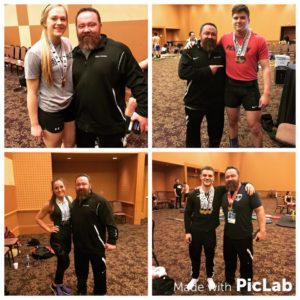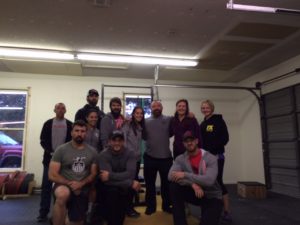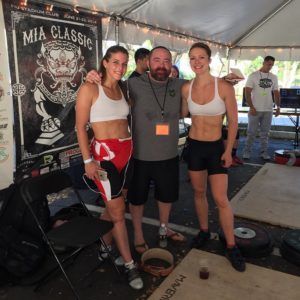Below is an article explaining how to build a perfect barbell club. My team is hosting a last chance qualifier for the American Open on October 24th! All of the proceeds will go to my amateur Weightlifters, so please come on out and lift with these guys and gals and help support their Olympic Dreams. Here is the Link:
Mash Mafia Meet: Lift with the Team!
Coaching Elites!
I just finished up a great weekend with some of my Mash Mafia Barbell Affiliates. It was fun to see a group of likeminded individuals come together to learn and hang out. The idea of starting a barbell club is something that all of them are in the process of, or they are already doing it. Personally I see a shift coming in the near future to more barbell clubs and less typical CrossFit classes.
One of the questions that I was asked is how does one come to coach elite athletes. The answer to this question will also explain the requirements necessary for greatness. Training elite athletes is not something that we are all cut out to do. Some of us are more gifted with coaching average athletes and making them achieve goals that they never thought possible. It doesn’t matter who you are coaching. It just matters that you are doing everything in your power for their dreams to come true.
Most of the athletes that I coach are either good or great. Every last person that I coach is hard working, driven, and talented. I don’t have to beg any of them to get in the gym. Most of the time I am telling them to go home and rest. This leads me to the first point:
1. Formulate a Culture of Greatness! You want to build your club with hard-working men and women that love to train. These same men and women cannot have limits. Their minds must be free of preconceived notions of potential. This aspect is the most important. Most physical limits are simply mental limits placed on the body by its owner. Erase those! As a coach my job is to help them erase limits, and to constantly help them shift their paradigms up.
The men and women training have to also possess the ability to have fun during grueling months of training. This is key! My team of athletes is the absolute best. We hang out together. We laugh together. We laugh when we train together. We enjoy being around each other, and that makes training a million times better.
The toughest thing that you will ever do as a coach is firing an athlete. Hopefully you will never have to. However, if you have an athlete that is an absolute cancer, you have to either fix their attitude or get rid of them. I personally hate this part, but I have learned from past mistakes that this step is crucial.
These culture demands will attract the best athletes. This is the final key for a great culture. When great athletes train together, great things will happen on the daily. I have several top ranked weightlifters in my facility right now. If one of them does something awesome, the others will kill themselves trying to match it. This is the secret to all great teams: Bulgarian, Chinese, Team MDUSA, the OTC, Westside Barbell, etc. This culture of great athletes banging it out is always the real “program”.
2. You have to know the coaching flow! This one is important, but it is the one most coaches screw up. When an athlete is first beginning the sport of weightlifting, they need lots of coaching on their technique. The first two years should be filled with drills, technique work, and lot of submaximal lifts. There shouldn’t be many misses at all because you want to teach the athlete how to make lifts.
After year two or three depending on the athlete’s development, the weights can start to creep up and the verbalized coaching will start to drop off some. Once the athletes are handling decent weights, weights above 85% of their max are moving way too fast to process multiple coaching ques. I recommend working on one or two things per session.
If you are telling the athlete to keep their chest up, stay over the bar, sweep back, shift your weight, move your feet, catch aggressively, and all of this at the same time, nothing good is going the happen. It will all get scrambled in the head. Choose one thing and drill it into their heads.
When the weight gets heavier, the coaching should get simpler. When my athletes are hitting near maximal weights, then my verbal cues get super simple. I sometimes resort to body signals, so they just deal with it visually. Body signals work better than verbal cues a lot of times. Visual cues seem to be easier to process.
3. Contest coaching must be on point! You have to know what’s going on. You need to be familiar with all of the rules. You have to know what it takes to qualify for events. I recommend spending some quality time on USAW’s website learning all of the rules and specifics.
Other than preparation, a coach has to have a championship demeanor in the back room. The coach must glow with confidence because the athlete will notice that confidence. Confidence is contagious, and so is anxiety! Along with confidence the coach has to be calm and cool. I like to smile and joke a lot so the athlete stays calm. Of course this too is dependent of the athlete. Some athletes like very little communication, and some enjoy more.
Rebecca Gerdon and Adee Zukier are my favorites to coach in the back room. They are listening to music, dancing, and having fun. Together we build a great atmosphere in the warm up room. Dylan Cooper likes a more quiet and focused atmosphere. This is where the coach has to know their athletes.
The biggest advice that I can give all coaches out there is to chill out with the verbal coaching at a competition. If you haven’t prepared your athlete up to this point, you aren’t going to prepare them now. Coaching at meets is watered way down. I most commonly give the cues of “patient pull” and “aggressive catch”. I might use “set your back” or “find your focal point” if I see a need, but that is about it. The athletes are already experiencing a sensory overload, so as coaches we don’t want to add to the overload.
3. Sincerely love your athletes! The athletes have to know that you are in this process with them to the end. They have to know that you have their best interest. Your job is to grow them as young men and women as well as athletes. I want my athletes to see me living a champion lifestyle, so they will do the same. I also want to set an example for them after sports. I want them to see me loving my family, and living a balanced life so one day they can do the same.
Folks, coaching is an important job. You are influencing these men and women sometimes more than their own parents, so you have to take it seriously. When your athletes see that they mean more to you than the numbers they are putting up, they will walk through fire for you. They know that you have their best interest, and now you have their trust. Trust is the key!
I hope that this helps you all formulate the perfect barbell club. I realize that I have the best job in the world. No one has to remind me! I love every aspect of what I do. One of my goals is to help all of you find a place in life where you are fulfilled and making a difference in the world. If there are any questions that I can answer with articles, feel free to ask questions below! I will answer all of them.
One more Underground Strength and Learn 2 Lift Dual Certs coming October 16 & 17th! Zach Even-Esh and I tearing it up together!
>>>>Underground Strength and Learn 2 Lift Dual Cert<<<<<
I have two workshops coming up! November 7th at Undisputed Strength & Conditioning in Eagan, MN and November 14th at the Mash Compound! These will be two-hour workshops with a training session to follow! Check them out below!
>>>>Mash Mafia Learn 2 Lift Workshops and Training Session<<<<




Awesome stuff!
What an amazing weekend it was. You latest podcast with John Broz was your best so far. Great article!
Usually, therapy might help scsle back the frequency and severity of episodes.